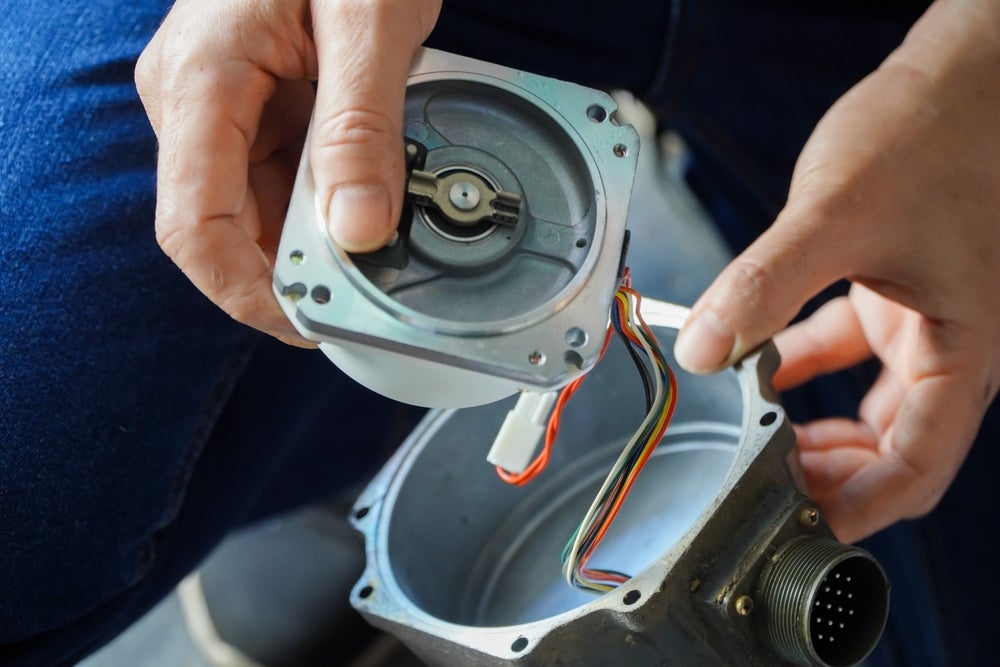
Motors are common electromechanical components that transfer electric energy to rotational mechanical energy.
Electromechanical components are everywhere in our modern devices, merging both electrical and mechanical functions. As more of our consumer products utilize these electromechanical components, its important to understand how they fit into the broader ecosystem of product development. Let’s delve into the purposes, applications, and ECAD + MCAD systems involved in designing electromechanical components.
|
Industry |
Application of Electromechanical Components |
|
Automation & Robotics |
Actuators, motors, and sensors for movement and feedback systems in robots. |
|
Consumer Electronics |
Mechanical parts in devices like printers and disk drives, driven by electrical signals. |
|
Aerospace |
Fly-by-wire systems using electromechanical actuators for precise control in modern aircraft. |
|
Electric Vehicles |
Components in battery management, propulsion, and user interface systems. |
|
Healthcare and Medical Devices |
Driving precise movements in MRI machines, integral in assistive devices like prosthetics and drug delivery systems. |
|
Industrial and Manufacturing |
Powering conveyor systems, precision in CNC machines, emergency disconnects for safety. |
|
Telecommunications |
Historically in telephone switching systems, currently in optimizing antenna adjustments for better signal reception. |
|
Entertainment |
Electromechanical elements in electric musical instruments, classic pinball machines, and various electric toys. |
|
Infrastructure and Utilities |
In elevators and escalators for movement, and in power grids for safety and efficient power distribution. |
Purposes of Electromechanical Components
Electromechanical components are devices that interact with their environment through both electrical and mechanical processes. These components can convert electrical signals to mechanical movement, allowing for various applications, from switches to robotic systems. The primary function of these components is to create a bridge between electronic and mechanical domains, allowing for the transfer of motion or data.
- Signal Conversion: Electromechanical components convert between electricity and mechanical realms.
- Electrical to Mechanical: A classic example would be the relay. When an electrical current flows through a coil in the relay, it creates a magnetic field. This field attracts a lever and changes the switch position, thus converting an electrical input into a mechanical movement.
- Mechanical to Electrical: Piezoelectric sensors, for example, generate an electrical charge in response to mechanical stress, converting physical pressure or vibration into an electrical signal.
- Functional Integration: Utilizing digital electronic functions in mechanical devices can lead to more efficient, compact, and reliable systems.
- Reduced Complexity: Electromechanical components can often replace multiple individual components, leading to simpler, more straightforward designs and fewer points of failure.
- Many electromechanical components, like certain motors, can be designed to optimize energy consumption, which is pivotal in applications like electric vehicles or portable electronics where battery life is paramount.
Common Electromechanical Components
Common instances of electromechanical components include relays, which trigger mechanical switches based on electrical signals, and actuators that turn electrical inputs into physical movements. Motors, a ubiquitous example, convert electrical power into mechanical motion, driving everything from fans to vehicles. Piezoelectric sensors and crystals produce electrical outputs when subjected to mechanical pressure or vibrations. Solenoids, which produce a magnetic field when electrified, are commonly used in locks and valves. Potentiometers, often found in volume dials, measure changes in resistance through mechanical rotation or movement.
Applications of Electromechanical Components
Electromechanical components are found in virtually all industries. Some highlights include:
- Automation & Robotics: Actuators, motors, and sensors are central to the movement and feedback systems in robots.
- Consumer Electronics: Devices like printers and disk drives have mechanical parts driven by electrical signals.
- Aerospace: Fly-by-wire systems in modern aircraft rely on electromechanical actuators for precise control.
- Electric Vehicles: As highlighted in “electromechanical components in electric vehicles”, these components play pivotal roles in battery management, propulsion, and user interface systems.
- Healthcare and Medical Devices: Electromechanical components drive precise movements in MRI machines and are integral in assistive devices like prosthetics and drug delivery systems.
- Industrial and Manufacturing: These components power conveyor systems, facilitate precision in CNC machines, and ensure safety with emergency disconnects in industrial setups.
- Telecommunications: Historically used in telephone switching systems, electromechanical parts today optimize antenna adjustments for better signal reception.
- Entertainment: Electromechanical elements breathe life into electric musical instruments, classic pinball machines, and various electric toys.
- Infrastructure and Utilities: Elevators, escalators, and power grids rely on electromechanical components for movement, safety, and efficient power distribution respectively.

Elevators are one of the many applications of electromechanical devices.
Developing Electromechanical Components
With products becoming increasingly complex and integrated, there’s a need to break down the traditional silos between electronic and mechanical design. That’s where the convergence of ECAD and MCAD comes in. Having ECAD and MCAD software that are able to communicate with each other in a seamless fashion is crucial for the following reasons.
- Merging ECAD and MCAD facilitates a unified design flow. Designers can easily integrate electronic circuits with mechanical casings, ensuring components fit perfectly, and avoiding late-stage redesigns.
- Real-time Collaboration: Cross-functional teams can collaborate in real-time, ensuring design coherence and speeding up the product development cycle.
- Enhanced Simulations: Integrated simulations can assess both electronic performance and mechanical durability, ensuring products are robust in real-world conditions.
- Optimized Components: With a holistic view, designers can select or create electromechanical components that precisely fit the system’s needs, whether it’s miniaturization, energy efficiency, or specific performance characteristics.
As we navigate the increasingly intertwined world of electromechanical design, it’s evident that an integrated approach to ECAD and MCAD is paramount for modern product development.Understanding how these components function and their wide array of applications offers invaluable insight.
If you’re looking for CAD models for common components for your designs with electromechanical components, Ultra Librarian helps by compiling all your sourcing and CAD information in one place.
Working with Ultra Librarian sets up your team for success to ensure streamlined and error-free design, production, and sourcing. Register today for free.








